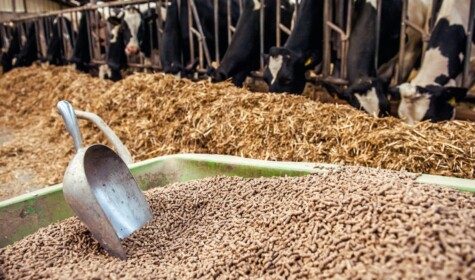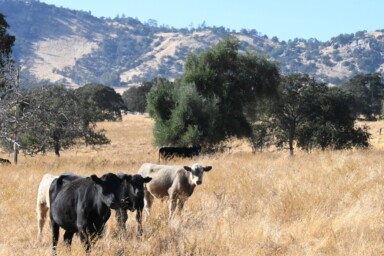Having effectively severed what should be an umbilical relationship between cows and the land they graze, Arla have now resorted to feed additives to maintain positive PR for their dairy farming industry.
I have been asked what I think about Arla’s feed additive, Bovaer, which apparently has the potential to reduce methane emissions from dairy cows by up to 30%. I have no detailed knowledge about its ingredients, which may well be patented, so I’m therefore not fully informed, but I imagine some of them may be bacterial, a bit like a starter culture which alters the fermentation environment of the rumen.
Bovaer has been declared safe and therefore harmless to consumers of products from treated dairy cows. Whether or not this proves to be true in the long term, it seems to me that feeding cows potions to reduce emissions is a classic case of the dairy industry, and I use that word advisedly, treating the symptoms rather than the cause of the problem. The cause in this case is separating the dairy cow from her natural environment of which she is intrinsically a part. Once this separation has occurred, both physically and in the mindset of society, methane becomes a problem which needs to be addressed by re-engineering the cow instead of ensuring that the ecosystem of which she is a part is restored in such a way that her emissions are counteracted by soil carbon sequestration.
If we go down the ‘re-engineering the cow path’, which is what Arla and other dairy industry organisations are proposing, I suspect all efforts to maintain a positive image for dairy products and the story behind them will fall on stony ground. I say this with the greatest respect for all those dairy farmers who have been forced to get big and intensify or get out. It’s clear to me that Arla’s potential solution to the methane emissions of their dairy herd is to set a target that, in future, all the herds in their cooperative are managed in such a way that the fields they graze sequester an amount of carbon that goes a long way towards offsetting the methane their herds emit.
I know for a fact that a significant number of Arla herds are managed in a way that means there is the potential to offset the methane emissions of the cows through holistic grazing systems that sequester soil carbon, as described above. However, the inconvenient truth for Arla is that a majority of the herds in the co-op are now what’s euphemistically called ‘fully housed’, a more accurate description being that they never get out to grass. Having effectively severed what should be this umbilical relationship between the cows and the land they graze, Arla have now resorted to feed additives to maintain positive PR for their dairy farming industry.
“… it seems to me that feeding cows potions to reduce emissions is a classic case of the dairy industry, and I use that word advisedly, treating the symptoms rather than the cause of the problem. The cause in this case is separating the dairy cow from her natural environment of which she is intrinsically a part.”
They are absolutely not alone in adopting this approach. Most of the leading organisations representing dairy farmers have signed up to this siloed carbon reduction strategy, advocating evermore intensive production from high-input herds producing enormous amounts of milk per cow, then arguing that the carbon footprint per litre is lower than the naturally managed counterparts. You can see this mentality and thinking reflected in organisations such as AHDB who ought to know better. It all comes from an absence of holistic thinking and a mindset which separates the cow as a unit of production from the nature around her of which she is a part.
An alternative strategy, which would be better for the cows and the dairy farming community in the long run, would be to make an announcement that the co-op will incrementally encourage, through price mechanisms, a transition over time towards producing milk from holistically managed grass-fed herds. Will they do this? Let’s hope so, but I fear that their current strategic direction will only be reversed if the negative publicity that results from their, in my view, misdirected feed additive strategy becomes so powerful that they are forced to change their approach.
I recently heard Chris Walkland, dairy analyst and commentator from Dairy Farmer Magazine, interviewed on BBC Radio 4’s Farming Today program implying that the storm of social media criticism of Arla’s promotion of the feed additive was irrational, before somewhat reluctantly recognising that the strength of public concern about adulteration of food integrity needed to be taken seriously. From my perspective, the fact that there has been such a strong reaction is an affirmation of the intuitive concern of the public who are rightly worried about the impacts of industrial farming on the integrity of the food they eat.
The problem as I see it is that the dairy farming community have been swept along a path of industrialisation and intensification. They have become commodity slaves, forced to produce and sell milk at, or even sometimes below, the cost of production in ever-larger herds where the farms have become platforms for imported fertilisers and feeds with huge negative consequences for biodiversity, environmental pollution, animal welfare and milk quality. Arla know this, but at a leadership level, they have been reluctant to face the consequences of the massive changes in infrastructure which will be necessary to achieve the climate, nature and social transition, not least because many of their board members are farming very intensively with permanently housed cows.
I know plenty of Arla dairy farmers and members of staff in the Arla community who would privately agree with this but may not be able to say so. Let us hope that these members of the Arla community can exert a stronger influence in future.







